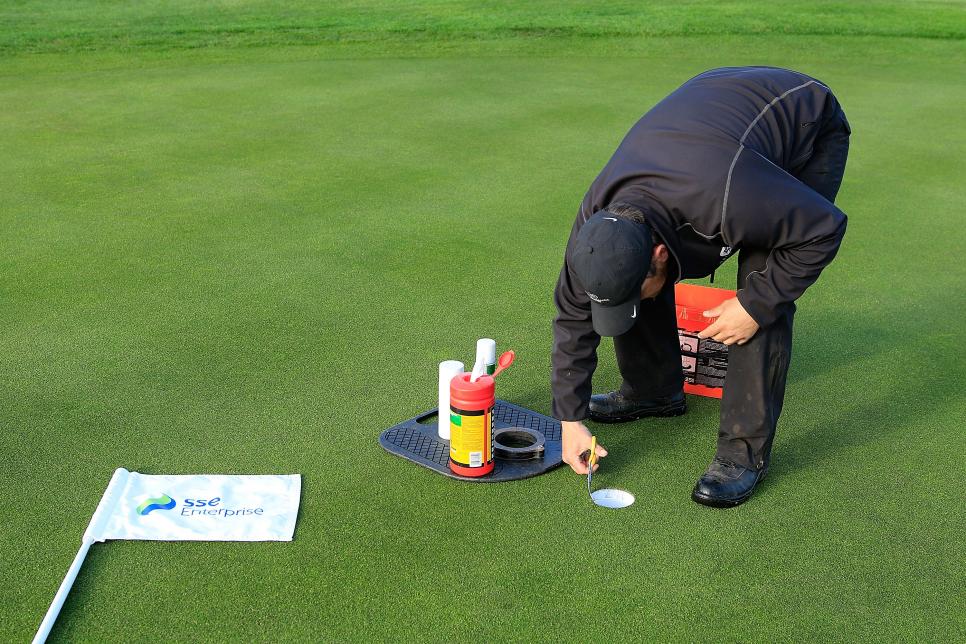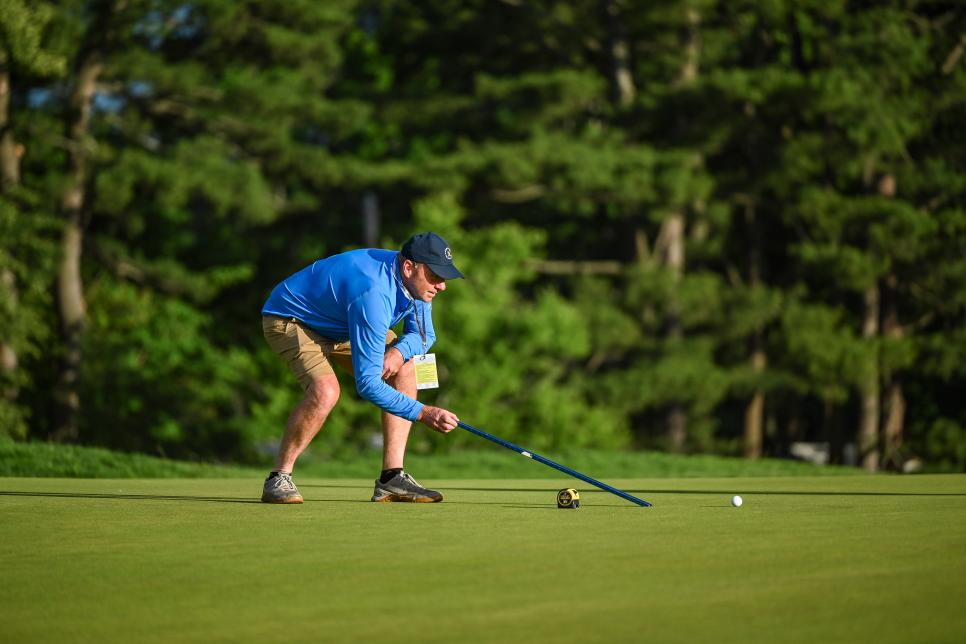How courses prep for high-level competition, according to top USGA experts – Australian Golf Digest

- by Admin
- August 23, 2024

Whether it be a club championship, member-guest or state amateur, every course, no matter the budget, prepares for tournaments throughout the year. Golfers have high expectations for course conditions during these weeks, so what are some things that courses can do to make these events particularly special?
That’s the question we put to two experts in championship preparation, Darin Bevard, the USGA’s director of championship agronomy, and Chris Tritabaugh, the golf course superintendent at Hazeltine National in Chaska, Minn. Bevard leads the preparation for many of the USGA’s championships, including the U.S. Open, and Tritabaugh has overseen course maintenance at Hazeltine for the 2016 Ryder Cup, 2019 KPMG PGA Championship and 2024 U.S. Amateur.
We recently spoke with Bevard and Tritabaugh at the U.S. Amateur at Hazeltine, to better understand how courses can prepare for tournaments and how the USGA works with courses to achieve top conditions for their championships. The below Q&A has been lightly edited for clarity and concision.
Stephen Szurlej false Private Hazeltine National Golf Club Chaska, MN, United States 4.2 153 Panelists
- Second 100 Greatest
- Best In State
Hazeltine might be the most controversial championship course of the modern era, designed by Robert Trent Jones for former USGA president Totten Heffelfinger, who used his considerable clout to bring the 1966 U.S. Women’s Open and 1970 U.S. Open to the then-very immature layout. Criticisms were so extreme that Trent Jones spent the next two decades remodeling it, straightening doglegs, relocating holes and rebuilding greens. In the past two decades his younger son, Rees Jones, assumed the reconstruction, with even greater success—and today the layout, like many in the old man’s portfolio, is more Rees than Trent. Hazeltine hosted the 2009 PGA and 2016 Ryder Cup, the latter a bright spot for the American team, which perhaps is why the PGA of America has already awarded the 2028 Ryder Cup to this Minnesota site. View Course
Golf Digest: Chris and Darin, based on your experience, what advice would you give courses looking to get in the best shape possible for their club championship, member-guest or another local event?
Tritabaugh: You superintendent should make sure to know the information about green speed, grass clippings, etc. If you go into a big event like a club championship and you are not sure where you’re at, it’s hard to get to where you want to be.
The other thing is, what touches can you add to make that event special? I can think of the home course that I worked at when I was a kid. It was a small budget course, but when we had our club championship, we added small touches that week.
It’s going to sound silly, but we string-trimmed around all the water features. We let the grass grow up, and then we’d go out and hack it all down. And you know what? I laugh about it now, but it looked nice, and we felt like we made this accomplishment. Those areas look better now than they looked before.
I remember we did two other things. We double cut the greens, which was a little extra feature, and we painted the lip of the cups. Those are three things, and that was at this little municipal course in a town of 1,500 people. It made it special.
So I would say to any course, think of something that might be as simple as those three things. What you do is going to be on a relative scale for every facility, but everybody has some little touch they can add that can make it special.
Like I said, it’s a relative scale, so each course should ask, “What is our standard?” Whatever your standard is, try to get there or try to get as close to it as possible for as many days as you can be.

Phil Inglis
Bevard: The only thing I’ll add is to hope for good weather. I’m amazed that at U.S. Opens, how stuff happens weather-wise and then a player makes a snide comment or something about conditions. It makes you want to say, “You realize it rained an inch and a half last night.” There’s certain things you can’t overcome when the weather doesn’t cooperate.
I do course consulting in my free time with the USGA, and I’m always amazed at the misconceptions that very smart people and good golfers have about what course preparation is and what their expectations are. That’s why having a set of standards is critical.
Wanting greens to be as fast as they can be every day is not a standard. A standard would be, “We want the greens between 12 and 12.5 feet every day on the Stimpmeter.” You can measure that, and say “Hey, we were there 80 percent of the time, or we were there 40 percent of the time.” Then you can realize that you’re either not getting it done or you have the wrong standard.
Golf Digest: Let’s transition to how you prepare for big championships like the U.S. Amateur. What are you focused on in the years, months and weeks leading up?
Tritabaugh: One of the things they asked when I got to Hazeltine was to keep the course at a championship level all the time, and not have a rollercoaster of conditions. I heard that a lot when I first got here. Members would say, “We’ve always been really great for our championships, and then it falls off, and it’s not the same.”
There’s an idea in the golf course maintenance world that you ride this wave, do some maintenance on a Monday, then peak towards something, and then you do some maintenance and then you peak again. Instead, what I’ve tried to do, especially after the 2016 Ryder Cup, is try to peak and be there all the time. Let’s do championship maintenance all the time.
Bevard: To Chris’ point, to reach peak conditions, you have to measure. I’m a big believer that you can’t evaluate stuff that you don’t measure. So, for example, what Chris has done is use technologies like the GS3 ball to measure smoothness, strength and firmness of the greens. That’s relatively new.
You’ll hear people say, “Oh, the Stimpmeter is the worst thing that happened to golf.” But I believe that if you don’t measure, how can you have an educated conversation about anything? It becomes he said, she said.

Keyur Khamar
When it comes to preparing for any USGA championship, like the U.S. Open or U.S. Amateur, it’s extremely important to collect data. We need to have information on clipping yields, impacts of green speeds, all of those things when you’re trying to prepare at this level. It’s the last 5 percent of everything that you do that gets a course from really good to a USGA championship level.
Golf Digest: Darin, you mention USGA championships. What are the main priorities for the USGA when you’re working to get a course to a championship level?
Bevard: Greens are the priority. Fairway widths, for a U.S. Amateur we’re not going to do a whole lot, but for some of our Open championships we narrow the fairways.
The other thing we focus on are the tees. Sometimes, like at Hazeltine, you’ve got quite a variety of tees, but we may go to another site that don’t have as many. We’ll get to sites, for example at the U.S. Girls Junior, and we might notice that the course doesn’t have a tee that fits the demographic, so we’ll build a new tee.
The other thing that we look at for a USGA championship is the rough. The general blueprint, if you will, is narrow fairways, deep rough and a premium on accuracy. That being said, someone can complain “Oh, the fairway on a hole is too narrow.” That’s just a talking point. If you screw up on the greens, that’s something that everyone can witness and say, “You can’t stop a ball within eight feet of that hole.” That’s why greens are the priority.
The other part of it that’s very important is the presentation side of it. We’ve got a lot of really good players in the U.S. Amateur field, but for 90 percent of them, this could be the biggest event they ever play in. You want them to have that feeling of, This is a big deal.
So we focus on the little things, like knocking off the dew from the courtesy walks in the morning. On the path to a tee, we’ll remove the dew. Does it matter in terms of what anybody’s going to shoot? No. But as that player is walking down the courtesy walk and sees that path through the dew on the tee in the morning, they’ll think, They did that for us.
MORE ASK A SUPER:
Why are practice greens slower than greens on the course?
Why’s the grass all brown on our course?
Why are you aerating our greens when they’re in perfect shape?
I repaired my ball mark, but it still doesn’t look right. What did I do wrong?
We all want fast greens, why can’t you just cut them shorter?
Why your superintendent is hoping for lots of snow this winter
Aerating greens, explained by a top course superintendent
This article was originally published on golfdigest.com
The Latest News
-
January 10, 2025UK seaside town leaves Australian tourist completely baffled
-
January 10, 2025Kyrgios steps up Australian Open preparation in a positive sign
-
January 10, 2025Watch Hideki Matsuyama (unintentionally!) hit his ball through an 8-inch gap in palm trees – Australian Golf Digest
-
January 10, 2025PGA Tour monitoring Los Angeles fires with Riviera stop scheduled in four weeks – Australian Golf Digest
-
January 10, 2025Melbourne Cup prize money goes missing after error





